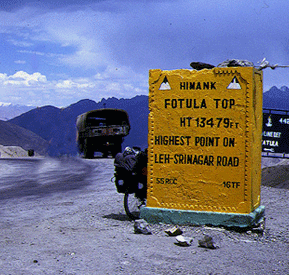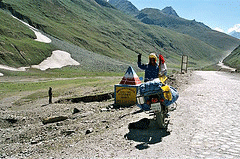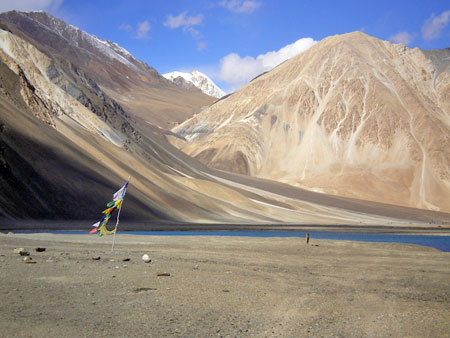
Welcome |
|
|
|
|
|
|
|
|
|
|
|
|
|
|
|
|
|
|
|
|
|
|
|
|
|
|
|
|
|
|
|
|
|
|
|
|
|
|
|
|
|
|
|
|
|
|
|
|
|
|
|
|
|
|
|
|
|
|
| |
|
|
|
|
|
Travel from Srinagar to Leh by Road |
|
Travelling into Ladakh by road is exciting and of adventures nature. It takes two days from Srinagar to Leh (434 km) with a mid way halt at Kargil, which
gives the visitor a marvelous introduction to this spectacular
destination, while easing the acclimatization process to the high altitude low-oxygen
atmosphere of Ladakh. The road leaves behind the beautiful valley of the Kashmir and drive through the Zoji-la
pass. Zoji-la pass in
the Great Himalayan wall is the gateway into Ladakh. Drass is the first village after having crossed the
pass. Drass is said to be the second coldest habitation in the world
after Siberia. Local people are of Dard origin and believed to be an Aryan people who migrated from the Central Asian steppes. Further the road
brings us to the little trading town of Kargil. Kargil is midway point of the road
journey to Leh. Kargil is
located on the River Suru, at 9000 feet, and the base to visit
the spectacular Suru and |
 |
 |
Zanskar valleys and
for a variety of adventure activities in the
region. Around 40 km ahead of Kargilis the
famous monastery Mulbekh famous for its
immense figure of Maitreya (the future Buddha).
The road further climbs its
adventures and breathless way to Namika-la pass (12,200 ft. or 3719m) and Fotu-la
pass (13,479ft. or
4094m), giving you a real feeling, being really at the top of the world. The Lamayuru Monastery is situated
spectacularly over a mountain side. On the way you will also come across the village Rizdong which is around
still 55 kms from away. |
|
|
Rizdong has a monastery and as well as a nunnery. The male lamas are residing in the Monastery and females are residing in the nunnery.
After passing the caves at Saspol one reaches at Alchi which has a large temple complex and is
considered as one of the most important Buddhist centres in Ladakh and is an
excellent example of perfect monastic
skill. There are five shrines in the Choskor complex which was constructed in the 11th century. Alchi has
splendid wall paintings. The plains of Alchi village and near by area
are very fertile and provides good and relatively extensive
agricultural land.
The next monastery is located at Likir (12 km) and then you reach
at the fortress of Basgo (10 km) which contains
the ruins of a Buddhist citadel impressively sited on a spur overlooking the Indus Valley. It served as a royal
residence for several periods between the 15th and 17th century. There are two Buddhist temples,
numerous chortens and mani walls beyond the village. The Maitreya temple of 16th century was constructed
by the Namgyal rulers. There is a large sculptures of Maitreya at the rear of the hall. The Serzang
Temple (God and
Copper) of 17th century is the other temple that contains murals depicting the Buddha
though these have suffered much from water damage. |
|
From here the road rises to another bare plateau that gives you the first glimpse of Leh, still 30 km away. You
then pass Phyang with its 16th century Gompa that houses hundreds of statues on wooden shelves, and finally
to Spituk (29 km). The Buddhist monastery here was founded in the 11th century but the
buildings here are later. It is constructed in a series of tiers with courtyards and steps. The long Dukhang hall (16th – 17th
century) is the largest building and has two rows of seats running the length of the walls to a throne at the
far end. Sculptures and miniature chortens are displayed on the altar.
The Mahakal Temple of 16th to 17th century |
 |
|
|
contains a shrine of Vajrabhairva which is often
mistaken for the Hindu goddess Kali. Her terrifying
face is only unveiled once a year in the month of
January. A collection of ancient masks can also be
observed in this chamber.
On the further drive, the Gompas and forts can be glimpsed in the distance. And at the Spituk Monastery the visitor gets a first dramatic glimpse of Leh.
The final approach to Leh can be disappointing after such a spectacular ride. Amidst stark mountains, the Indus valley widens and before entering the city
you go through a vast expanse of army huts. Then you see Leh,
all the buildings piled up on one another and topped by the ancient, but unused palace. |
|
|
|